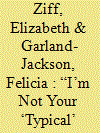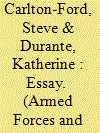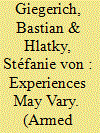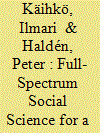|
|
|
Sort Order |
|
|
|
Items / Page
|
|
|
|
|
|
|
| Srl | Item |
| 1 |
ID:
173117


|
|
|
|
|
| Summary/Abstract |
Within the institution and military community, civilian wives of service members occupy complicated roles. On the one hand, wives are undisputedly crucial to the functioning of their service member husbands. However, wives are simultaneously considered subordinate to their husbands within the military and extended community. Indicative of this attitude are the divisive stereotypes of military wives that range from lazy and irresponsible, to overly rank-conscious and entitled. Based on combined in-depth interviews from two samples of military wives, this article investigates how the women navigate the military spouse role within the institutional, community-oriented context of the military. Specifically, we ask, how do these women construct gender and exercise agency when drawing on the stereotypes of wives within the community? By utilizing such mechanisms as symbolic boundary work, gender policing, and stereotyping, women both reify stereotypes of the military spouse and exert agency in creating the military spouse identity for themselves.
|
|
|
|
|
|
|
|
|
|
|
|
|
|
|
|
| 2 |
ID:
173121


|
|
|
|
|
| Summary/Abstract |
Drawing upon 106,181 patent applications by the world’s largest defense firms and 241,571 patent citations (2002–2011), this article has two main objectives. The first is to explore the factors affecting the production of mixed patents (those with potential dual applications in both military and civilian spheres). The second is to identify the causes of the use of military knowledge for civilian inventions (spin-off) and the use of civilian knowledge in military patented technologies (spin-in). Our calculations show highly significant coefficients for the variables capturing the “military technological capability” and the size of the company in explaining the production of mixed technologies. The spin-off process is affected by the military technological capability, the size of the firm, and the location. The spin-in mechanism is explained by the military technological capability and the location of the firm, while the size of the company is not relevant.
|
|
|
|
|
|
|
|
|
|
|
|
|
|
|
|
| 3 |
ID:
173120


|
|
|
|
|
| Summary/Abstract |
Our research, based on a sample of 500 veterans currently studying at Israeli colleges and universities, suggests that certain aspects of military service are associated with greater entrepreneurial intentions. Specifically, the desire to engage in entrepreneurship is higher among veterans with command experience than veterans without. Similarly, veterans of technological units generally express greater entrepreneurial interest than veterans of combat units. A comparison of commissioned and noncommissioned officers yields curious results and offers a possible direction for further investigation. Although Israel is among the few countries that maintains a mandatory draft, the general applicability of these findings to countries with volunteer forces is discussed.
|
|
|
|
|
|
|
|
|
|
|
|
|
|
|
|
| 4 |
ID:
173125


|
|
|
|
|
| Summary/Abstract |
“The Soldier, the State, and the People—Costs and Benefits of Military Regimes”: Evaluating the Essay “Guns and Butter: Child Mortality and the Mediators of Militarization” raises several concerns about the theory and analyses in our article. We address what we see as the three most important: (1) the necessity of both qualitative and quantitative analyses in the study of militarization; (2) correlational versus causal analysis; and (3) the value of Huntington’s analysis of praetorian militarization. We have varying levels of agreement.
|
|
|
|
|
|
|
|
|
|
|
|
|
|
|
|
| 5 |
ID:
173123


|
|
|
|
|
| Summary/Abstract |
This article examines the coherence of the North Atlantic Treaty Organization’s (NATO) coordinated military strategy during the war in Afghanistan. We argue that much of this coherence can be lost when decision makers adopt multinational strategic guidance that is then interpreted by different national contingents operationally. Different strategic and military cultures across troop-contributing countries may account for observed variation in operational outcomes, but better theoretical tools are needed to examine this phenomenon. Our aim is to further scholars’ understanding of how cultural variables can affect mission outcomes. This assumed effect of strategic and military cultures is explored empirically with reference to the Canadian and German Provincial Reconstruction Teams in Afghanistan, which formed part of the NATO-led ISAF operation.
|
|
|
|
|
|
|
|
|
|
|
|
|
|
|
|
| 6 |
ID:
173118


|
|
|
|
|
| Summary/Abstract |
Military spouses, most of whom are women, often contend with a number of factors that can influence their employment status. Previous studies have examined the role of service-member and spousal demographic characteristics on wives’ employment. However, little is known about the role spousal mental health has on employment while controlling for demographic characteristics. Using repeated-measures logistic regressions, this longitudinal study explored associations between spousal mental health and employment while controlling for service-member and spousal characteristics in a sample of 1,164 women. Fewer depressive symptoms were significantly associated with employment (p < .05). Spouses of enlisted personnel, women who were older, racial/ethnic minorities, homeowners, or had city stability, had higher odds of employment (p < .05). Military spouses of active duty service members and those less educated had lower odds of employment (p < .05). Depressive symptoms and demographic characteristics should guide employment opportunity programs for military spouses.
|
|
|
|
|
|
|
|
|
|
|
|
|
|
|
|
| 7 |
ID:
173124


|
|
|
|
|
| Summary/Abstract |
In October 2018, Armed Forces & Society published a special issue dedicated to broadening the perspective on military cohesion from the narrow focus on 20th and 21st Western state militaries and the microlevel. The special issue emphasized the need for a theoretical and methodological broadening of the study of cohesion: In order to understand the majority of armed groups in the world, it is necessary to investigate macro- and mesolevel preconditions of microlevel cohesion. Such preconditions include the existence of states, nations, and modern military organization. These are specific to modern, Western contexts, and rarely feature in historical or non-Western cases. In many cases, investigating these preconditions requires qualitative methods. In a critical response, Siebold contested some of the arguments of the special issue, claiming that our argument was exaggerated and our methodologies inadequate. In this reply, we seek to clarify some of the issues and arguments at stake.
|
|
|
|
|
|
|
|
|
|
|
|
|
|
|
|
| 8 |
ID:
173119


|
|
|
|
|
| Summary/Abstract |
U.S. National Guard (NG) military personnel experience many barriers to care such as limited access to health-care services and geographic separation from service providers. Although stigma and barriers to mental health care have been examined in the military, little is known about how different facets of stigma and barriers to care might impact different military subgroups. In a sample of 965 NG personnel, latent class analysis was used to identify distinct subgroups of stigma and barriers to care. Four groups were identified: no stigma or barriers (31%), mild stigma and barriers (30%), high stigma and career concerns (20%), and moderate stigma and barriers (20%). Classes significantly differed with respect to several demographic characteristics, rates of mental health conditions, and rates of previous suicidal thoughts and behaviors. Results suggest that different subgroups of NG personnel vary with respect to levels of perceived stigma, barriers to care, and mental health needs.
|
|
|
|
|
|
|
|
|
|
|
|
|
|
|
|
| 9 |
ID:
173116


|
|
|
|
|
| Summary/Abstract |
Despite the expansion of absentee voting protections as recently as 2016, Service member spouses have not enjoyed the same level of voting protections as Service members. Active duty military spouses, uniquely positioned between military service and civilian life, are arguably as important to the election process as their Service member counterparts. Thus, we examine the voting behaviors of this underserved and seldom studied subpopulation. Matsusaka’s information theory–based economic model of voter turnout provides our framework for identifying determinants that shape the voting interest and participation of active duty military spouses. We analyze the Federal Voting Assistance Program’s 2010 Post-Election Voting Survey of Active Duty Military Spouses utilizing logistic regression models. We found that voting interest and participation were increased among respondents who planned to vote, received more election information, voted within the previous 6 years, and who were older; however, voting interest and participation were not diminished by absentee status.
|
|
|
|
|
|
|
|
|
|
|
|
|
|
|
|
| 10 |
ID:
173122


|
|
|
|
|
| Summary/Abstract |
This article argues that military organizations display a more rigorous form of collective sensemaking than ordinary bureaucratic organizations. Military organizing is predicated on the rigorous modes of thinking and acting that follow from the particular military propensity to impose order on chaos. This trait is antithetical to modern notions of “the learning organization,” in which exploring variety and experimenting and testing out unproven methods are central. We identify two sets of structural conditions that constitute the sociocognitive landscape of military organizations and discuss how the military logic of action might be enacted in different sociocultural contexts. Our framework is brought to bear on recent research on international military missions, and in the concluding section, we summarize our arguments and discuss their wider implications in terms of trade-offs between adaptability and other capabilities in the design of military forces.
|
|
|
|
|
|
|
|
|
|
|
|
|
|
|
|
|
|
|
|
|